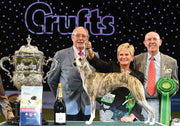Winning an award at crufts is prestigious - but is it profitable?

If you sit glued to your seat in front of the TV watching the glitz and glamour of the Crufts dog show each year - or if you are lucky enough to make it to the show in person and get up close and personal with the competitors and take a ringside seat for the judging - you might well think that taking home a major prize means taking home some major money.
That being the case, you might be surprised to know that taking home a big prize from Crufts isn’t going to make you rich in and of itself - and that it’s going to cost you a lot more money simply for the pleasure of competing than you are likely to get back in return. Think that all bets are off if you happen to beat out thousands of other dogs from all over the world and win the giant solid silver Best in Show trophy? Think again! The trophy itself isn’t yours to keep - you only get to hold onto it for a year, before it is passed on to the following year’s winner.
So, how much does the Best in Show winner at Crufts actually win? A token prize of just £100, plus their own replica of the trophy, which is only silver coloured.
Showing dogs - particularly at the highest levels such as Crufts - is very expensive, and it is highly unlikely to make you rich. Unless you are a professional dog breeder who consistently produces show winners, competing at Crufts and the pre-show heats for Crufts is probably going to leave you out of pocket, and potentially, struggling to raise enough money to compete at all.
In this article, we will look at the various costs involved in showing dogs at a high level, as well as the financial rewards of doing so if you are successful. Showing dogs is definitely not a cheap hobby - so make sure you find out the facts before you start seeing ££ signs in front of your eyes! Read on to learn more.
The costs involved in owning a show-standard dog
Before you can even think about taking part in a formal Kennel Club dog show to take your first step on the road towards Crufts, you need to have the right dog!
Pedigree dogs that are registered with the Kennel Club are eligible to compete in Kennel Club events - but not all pedigree dogs have what it takes to make the grade.
If you want to get involved in breed-specific dog shows and qualifiers for high-level competitions such as Crufts, you will need a top-quality show-standard dog who has all of the potential to make it as a future winner.
Puppies from highly respected breed lines and with lots of show winners in their ancestry are not only in very high demand, but they are also very expensive. Many people who want to show dogs wait years for the right puppy to come along, and will usually have to pay many thousands of pounds to secure it.
Additionally, many dog breeders will keep their very best puppies to show themselves in order to increase their reputation and demand for future litters, so if you’re not involved in breeding, finding and convincing a breeder to sell you one of their bet pups can be really hard.
Even if you manage to buy a great quality pup with bags of potential, they may not be successful in shows - not every dog has the right temperament, health or other core traits to succeed in the show ring, and there is also a lot of stiff competition out there too.
To get yourself a potential future show winner, you will need to invest a lot of money in the initial purchase price for the dog, health testing to ensure their fitness to compete, and of course, the best quality and most appropriate care, food and accessories for the dog for the entire duration of its life, even if it becomes obvious early on that they’re never going to win big prizes.
The cost of showing dogs at a high level
Even if you have a potential show-ring star, the cost of showing itself can be prohibitively expensive. You have to take into account not only entry fees for the shows themselves, but also the cost of everything relating to showing such as accessories, expert advice and potentially, the cost of hiring a top-level handler to show your dog in their best light. Your dog will need to look and feel their best too, which may mean finding a top level groomer to prepare them for the show, and taking professional instruction in stage craft and handling before you get into the ring.
There is also the cost of travelling all over the country (and perhaps further afield) to get to shows, and providing accommodation for you and your dog - which must be calculated in terms of not only money, but time too. If you are serious about showing and make it your priority, it is likely to take over your life, and make it hard to juggle paid employment and other commitments as well.
Showing dogs at a high level is like an unpaid job - one that actually costs you money. It can of course also be hugely rewarding and enjoyable, and many regular competitors wouldn’t have it any other way - but if you don’t have the time, money or commitment to go the distance, you won’t last long!
Can showing dogs be profitable?
As we outlined in the introduction, even winning Best in Show at Crufts - the absolute highest award a dog can win - does not come with a big monetary prize.
However, high-level dog show competitors and breeders that produce dogs for the show ring can of course make money to fund their endeavours and potentially make a profit - if they are very successful.
The financial rewards for high-level show success come in the form of sponsorship deals from pet-related companies who will often pay a pretty penny to feature top class winners in their marketing media - and of course, the potential value of stud fees or puppies from show-winning dogs.
Even other litters produced by dogs that are related to a high-level show winner or that come from the same breed line will be able to command a premium as their bloodline has a proven track record of success.
However, even if you take home the Best in Show trophy like 2018’s winner Tease (a whippet) top-level dog show success is still highly unlikely to make you rich.
Sorry!
(Article source: Pets 4 Homes)




